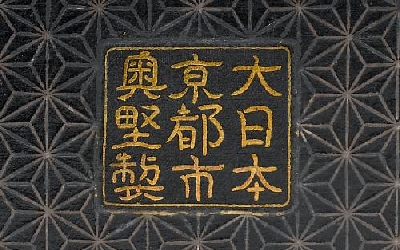Komai Otojiro 駒井音次郎 (1842-1917)
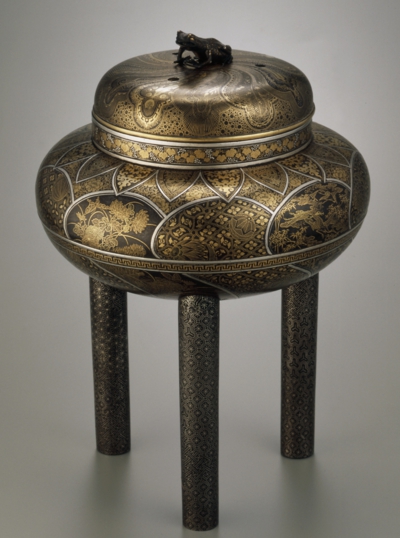 Komai workshop, Incense burner with inlaid floral designs in textured panels, hight: 29 cm, Sannenzaka Museum, Kyoto.The Komai family worked as a sword furniture maker in Kyoto for generations. Though the Komai firm is believed to had been founded in 1841 by Komai Seibei 駒井清兵衛, it was during the time of Komai Otojiro 駒井音次郎, regarded as the first-generation proprietor, that the workshop initially produced works displaying the renowned textured inlay in gold and silver, "Nunome-Zougan 布目象嵌".
Komai workshop, Incense burner with inlaid floral designs in textured panels, hight: 29 cm, Sannenzaka Museum, Kyoto.The Komai family worked as a sword furniture maker in Kyoto for generations. Though the Komai firm is believed to had been founded in 1841 by Komai Seibei 駒井清兵衛, it was during the time of Komai Otojiro 駒井音次郎, regarded as the first-generation proprietor, that the workshop initially produced works displaying the renowned textured inlay in gold and silver, "Nunome-Zougan 布目象嵌".
It was 14th century that Nunome-zogan technique was imported to Japan, which was invented in Damascus, Syria in 12th century. Sword furniture in Muromachi period applied this technique already. At present the tradition of Nunome-zougan technique is surviving at Kyoto, Ishikawa, Kumamoto in Japan and Toredo in Spain. Each area in Japan has very long tradition of the sword furniture.
At the age of thirteen, Komai Otojiro had the opportunity to study inlay techniques with Misaki Shusuke 三崎周助, a sword-fitting artisan from Higo 肥後 (present Kumamoto). Otojiro produced sword fittings up until the 1876 Haitou-rei (廃刀令) prohibiting against wearing swords, but in 1873 he had already begun to produce decorative objects aimed at the export market.
Around 1873 Komai Otojiro started selling damascened ironwares in Kobe, a centre of foreign trade, and within a few years his chargers, plaques, cabinets, model pagodas, and vases were in such demand that he was prosperous enough to buy a large house.
In 1885 he lost his home and property in a fire. He had made large art objects - Okimono (置物) before the fire, after then he started to make more practical low-price utensils like a cigarette case or a jewelry box mostly. This is due to the marketing strategy by Ikeda Seisuke 池田清助, a dealer marketing Komai's works exclusively. He intended to expand the target client segment from Ultra HNWIs to affluents to enhance the revenue by employing low cost workers under the well-known Komai brand. Otojiro devoted himself to make higher quality pieces for national or foreign exhibition to establish the Komai brand.
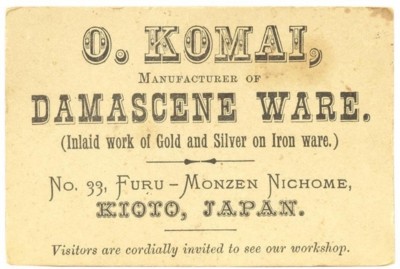 Buisiness card of Komai shop. Address: No.33 Furu-Monzen Nichome, Kioto, Japan (京都市古門前縄手東入貳丁目33番)His works were shown at foreign exhibitions, probably starting with the Nuremberg Metalwork Exhibition of 1885. where Japan was able to show 492 pieces and won the top prize. The name of Komai seldom appears in the lists of artists for international or national exhibitions. He won prizes at national exhibition (内国勧業博覧会) in 1903, Louisiana Purchase Exposition in 1904 and Exposition Universelle et Internationale de Liège in 1905.
Buisiness card of Komai shop. Address: No.33 Furu-Monzen Nichome, Kioto, Japan (京都市古門前縄手東入貳丁目33番)His works were shown at foreign exhibitions, probably starting with the Nuremberg Metalwork Exhibition of 1885. where Japan was able to show 492 pieces and won the top prize. The name of Komai seldom appears in the lists of artists for international or national exhibitions. He won prizes at national exhibition (内国勧業博覧会) in 1903, Louisiana Purchase Exposition in 1904 and Exposition Universelle et Internationale de Liège in 1905.
It was Ikeda Seisuke 池田清助, a dealer marketing Komai's works, who won a gold medal at the Paris Universal Exposition of 1900 for a plate of gold and silver which may well have come from the Komai workshop. Presumably because Ikeda Seisuke, a owner of Ikeda partnership corporation 池田合名会社, marketed most of Komai's work exclusively.
Komai Otojiro's delicate and highly detailed work was very well received abroad, and other artisans in Kyoto began to produce similar objects, for example, Okuno 奥野, Asai 浅井 and so on.
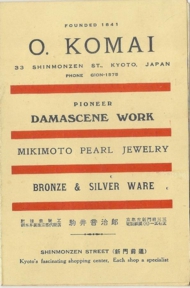 Advertisement of Komai Company. His name was described "音治郎 (Otojiro)", his title is "肥後象嵌工 (Higo-zougan-kou)" means an Inlay worker trained in Higo (current Kumamoto Prefecture) and his shop is "御木本真珠京都代理店 (an agent shop of Mikimoto Perl Shop in Kyoto)". Address: 京都市新門前33 (33 Shin-Monzen, Kyoto)".
Advertisement of Komai Company. His name was described "音治郎 (Otojiro)", his title is "肥後象嵌工 (Higo-zougan-kou)" means an Inlay worker trained in Higo (current Kumamoto Prefecture) and his shop is "御木本真珠京都代理店 (an agent shop of Mikimoto Perl Shop in Kyoto)". Address: 京都市新門前33 (33 Shin-Monzen, Kyoto)".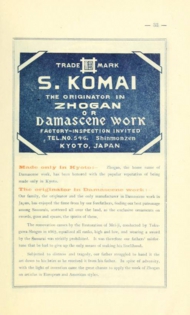 Advertisement of Sobei Komai's shop. He claimed himself as the originator and the only manufacturer in Damascene work (Zougan) in Japan. Of course it was not true.He retired in 1906 and reffered to himself Shuryou 周亮. His son Seibei 清兵衛 (1883-1970) took the name Otojiro II, continuing to work until 1912. Otojiro II continued to submit Komai works to exhibitions - St.Petersburg in 1908, Seatttle in 1909, Brussels and London in 1910 and Vienna in 1913.
Advertisement of Sobei Komai's shop. He claimed himself as the originator and the only manufacturer in Damascene work (Zougan) in Japan. Of course it was not true.He retired in 1906 and reffered to himself Shuryou 周亮. His son Seibei 清兵衛 (1883-1970) took the name Otojiro II, continuing to work until 1912. Otojiro II continued to submit Komai works to exhibitions - St.Petersburg in 1908, Seatttle in 1909, Brussels and London in 1910 and Vienna in 1913.
It is thought that larger pieces such as model pagodas started to be made during the latter period of the company's activity; one pagoda was acquired by the Walters Art Gallery, Baltimore, in 1915. These pieces can be distinguished from early large pieces by Otojiro I by its applied techniques.
The Komai firm continued to produce metal work objects until 1941. At some stage, Seibei Komai started to sell perl jewelry as an agent shop of Mikimoto Perl Store (御木本真珠店). He needed a partner to promote his works to the overseas market instead of Seisuke Ikeda and also expand the products line-up in his shop.
Kokichi Mikimoto (御木本幸吉 1858-1954) succeeded to make the world's first semi-spherical cultured pearl in 1883 at Toba (鳥羽), Mie Prefecture and exhibited his perl at World's Columbian Exposition (Chicago Expo) in 1893. In 1899 he opened Mikimoto Perl Store at Ginza, Tokyo and established a Japan’s first full-scale jewelry production facility, Mikimoto Gold Work Factory (御木本金細工工場) in 1907. He opened the first overseas Mikimoto Pearl Store in London in 1913. He had strong ability of the marketing to the affluent overseas clients.
After World War II, Komai shop specialized in the pearl trade and their marvelous textured inlay technique was lost forever.
 Large Dish, signed NIHON KOKU KYOTO JU KOMAI SEI, late 19th century. The rim decorated in gold overlay and low relief with silver details. The central roundel depecting a temple scene before mountain full bordered by scatttered mon on a patterned ground. The rim with vine. 54.5cm diam. It was sold at GBP 21,510 at Christie's London on 10 November 2004.
Large Dish, signed NIHON KOKU KYOTO JU KOMAI SEI, late 19th century. The rim decorated in gold overlay and low relief with silver details. The central roundel depecting a temple scene before mountain full bordered by scatttered mon on a patterned ground. The rim with vine. 54.5cm diam. It was sold at GBP 21,510 at Christie's London on 10 November 2004.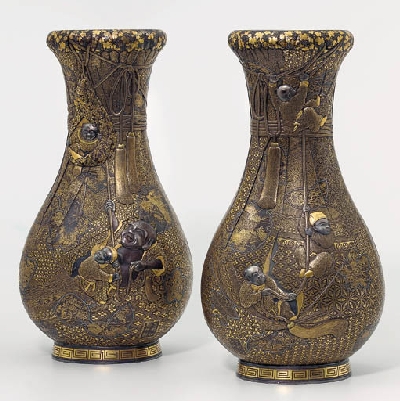 Vase signed Komai, circa 1880-1900. Each of flattened baluster form with ovoid body on a tall splayed foot, widening again towards the mouth which is formed as the gathered part of a curtain which hangs over the rest of the vase, Hotei and a group of karako [Chinese boys] playing with the curtain-ropes, the foot with keyfret patterns, the mouth with vine-leaves and grapes, the curtains and other areas of the surface in a variety of geometric patterns derived from textiles, interspersed with panels showing views in and around Kyoto, bird and flower motifs, a Chinese sage and other subjects, all this decoration executed in gold overlay and low relief with details in silver, each vase signed in gold overlay within a border just above the foot Kyoto no ju Komai sei [made by Komai of Kyoto] 12 3/8in. (31.4 cm.) high. Sold at £44,650 in Christie's on 20 June 2001.
Vase signed Komai, circa 1880-1900. Each of flattened baluster form with ovoid body on a tall splayed foot, widening again towards the mouth which is formed as the gathered part of a curtain which hangs over the rest of the vase, Hotei and a group of karako [Chinese boys] playing with the curtain-ropes, the foot with keyfret patterns, the mouth with vine-leaves and grapes, the curtains and other areas of the surface in a variety of geometric patterns derived from textiles, interspersed with panels showing views in and around Kyoto, bird and flower motifs, a Chinese sage and other subjects, all this decoration executed in gold overlay and low relief with details in silver, each vase signed in gold overlay within a border just above the foot Kyoto no ju Komai sei [made by Komai of Kyoto] 12 3/8in. (31.4 cm.) high. Sold at £44,650 in Christie's on 20 June 2001.
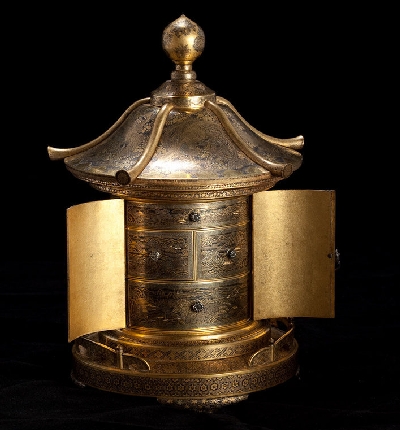 Pagoda ornament signed Komai, circa 1880-1900.
Pagoda ornament signed Komai, circa 1880-1900.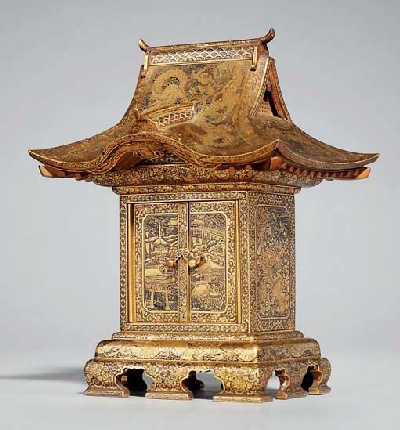 A CABINET, Fuji mark of the Komai workshop, late 19th century. In the form of a temple, decorated in gilt nunomezogan, the roof chased with dragons, pheasants and ho-o birds, the two hinged doors open to reveal three small drawers engraved with village landscapes, wood stand
15.8cm high. This was sold at $ 15,600 at Christie's Zurich on 19 February 2007.
A CABINET, Fuji mark of the Komai workshop, late 19th century. In the form of a temple, decorated in gilt nunomezogan, the roof chased with dragons, pheasants and ho-o birds, the two hinged doors open to reveal three small drawers engraved with village landscapes, wood stand
15.8cm high. This was sold at $ 15,600 at Christie's Zurich on 19 February 2007.
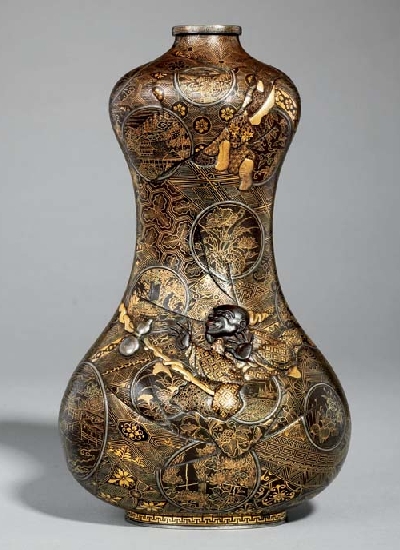 IRON VASE signed Nihon koku Saikyo Jyu Komai Sei, late 19th century. Decorated in gold and silver nunomezogan and cast in high and low relief with Tekkai Sennin expelling his minature self from his breath and disappearing among brocade and numerous roundels of geometric and floral designs
21cm. high. This was sold at $ 25,350 at Christie's Zurich on 19 February 2007.
IRON VASE signed Nihon koku Saikyo Jyu Komai Sei, late 19th century. Decorated in gold and silver nunomezogan and cast in high and low relief with Tekkai Sennin expelling his minature self from his breath and disappearing among brocade and numerous roundels of geometric and floral designs
21cm. high. This was sold at $ 25,350 at Christie's Zurich on 19 February 2007.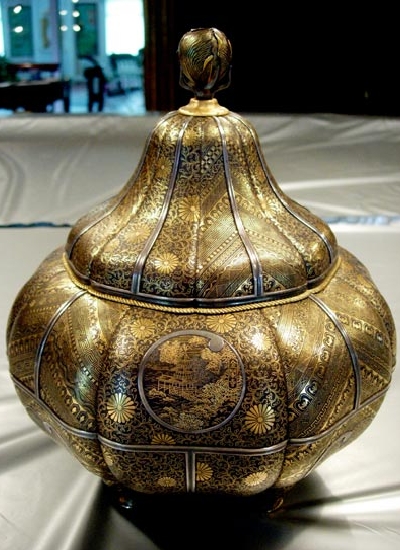 Lidded Vase signed Komai, late 19th century. Victoria & Albert Museum.
Lidded Vase signed Komai, late 19th century. Victoria & Albert Museum.
 Komai's signiture "Nippon-koku Kyoto jyu, Komai-sei"
Komai's signiture "Nippon-koku Kyoto jyu, Komai-sei" 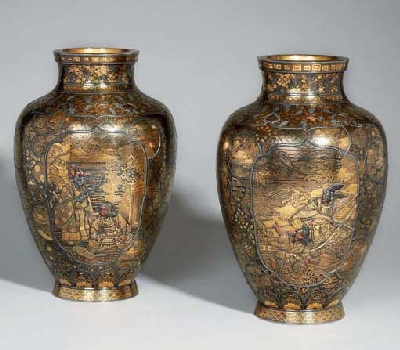 A PAIR OF IRON VASES signed Nihonkoku Kyoto jyu Komai sei, late 19th century. Each decorated in gold and silver nunomezogan, iroe-takazogan and silver framework in relief, with panels, one possibly depicting Minamoto no Yorimasa between roundels and geometric panels beneath band of grapevine to the shoulders, 24cm. high. This was sold at $ 58,500 at Christie's Zurich on 19 February 2007.
A PAIR OF IRON VASES signed Nihonkoku Kyoto jyu Komai sei, late 19th century. Each decorated in gold and silver nunomezogan, iroe-takazogan and silver framework in relief, with panels, one possibly depicting Minamoto no Yorimasa between roundels and geometric panels beneath band of grapevine to the shoulders, 24cm. high. This was sold at $ 58,500 at Christie's Zurich on 19 February 2007.
Okuno Company
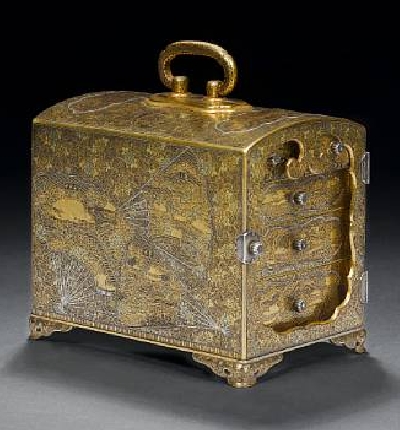 Inlaid iron kodansu by Okuno, Kyoto, Meiji Period. The rectangular arched body raised on four bracket feet with pierced hinged door enclosing five drawers, worked throughout in gold and silver nunomezogan with panels in the forms of overlapping fans enclosing views of famous temples and landmarks in Kyoto including Kiyomizu-dera, Hirano, Kinkakuji, Arashiyama, Uji and Maruyama on a ground of dense scrolls and kikumon, the top worked with the Four Sacred Creatures (shishin), the suzaku, gembu, byakko, and the seiryu, each animal associated with a cardinal direction, one of the four seasons and seven of the twenty-eight Celestial Mansions; the drawers decorated with ho-o and rural landscape and applied with a silver kiku-head knop, signed Dai Nihon Kyoto shi Okuno sei. 11cm x 14cm (4¼in x 5½in).The particularly dense style of decoration is quite different from that of the better-known Komai Company. The Okuno and Otsuno Companies represent an interesting group of contemporary competitors. However it is known that Komai Otojiro I's sister founded a rival firm producing wares in the same style and although there is no proven evidence it could be possible that both these companies were indirectly connected with the family.
Inlaid iron kodansu by Okuno, Kyoto, Meiji Period. The rectangular arched body raised on four bracket feet with pierced hinged door enclosing five drawers, worked throughout in gold and silver nunomezogan with panels in the forms of overlapping fans enclosing views of famous temples and landmarks in Kyoto including Kiyomizu-dera, Hirano, Kinkakuji, Arashiyama, Uji and Maruyama on a ground of dense scrolls and kikumon, the top worked with the Four Sacred Creatures (shishin), the suzaku, gembu, byakko, and the seiryu, each animal associated with a cardinal direction, one of the four seasons and seven of the twenty-eight Celestial Mansions; the drawers decorated with ho-o and rural landscape and applied with a silver kiku-head knop, signed Dai Nihon Kyoto shi Okuno sei. 11cm x 14cm (4¼in x 5½in).The particularly dense style of decoration is quite different from that of the better-known Komai Company. The Okuno and Otsuno Companies represent an interesting group of contemporary competitors. However it is known that Komai Otojiro I's sister founded a rival firm producing wares in the same style and although there is no proven evidence it could be possible that both these companies were indirectly connected with the family.
Compare with another inlaid iron kodansu by Okuno in the Nasser D. Khalili Collection, illustrated, Meiji no takara, Treasures of Imperial Japan, Metalwork, part I, no.31.
 Top
Top Site Map
Site Map References
References About Me
About Me
